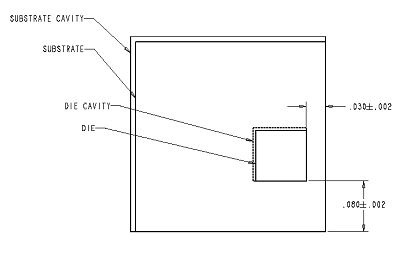SST designs tooling to precisely locate solderable components to our customer’s requirements. The methodology that the package designer uses to define the locations of the components varies and affects the tool design.
Two common dimensioning schemes are used by designers in the assembly of die to substrates or packages. One scheme is to provide dimensions from the corners of the substrate/package to the corner of the die. The other is to provide dimensions from the substrate/package centerline to the die centerline (there are also schemes that use a combination of the two, which will not be addressed here).
If the dimensioning is to the center, then the tooling is simpler in design, cost, and complexity. But, if size tolerances are larger than the locational tolerances, the desired locational tolerance may not be achieved. On the other hand, if the parts are dimensioned to the corners and if the size tolerances on the components are larger than the tolerances of location, then the parts must be shoved into a corner to eliminate the size tolerances from the equation.
In the example shown below, the die and substrate are assumed to have a size tolerance of plus/minus .005” (5 mils), and the lower right corner of the die is referenced to the lower right corner of the substrate with a placement tolerance of plus/minus .002” (2 mils). In order to meet this locational tolerance, both the substrate and the die must be pushed into the lower right corner of the fixture.

Since simply manually pushing the components into a corner does not prevent the subsequent movement of due to handling or other factors, they must be held in this position. This can be done in several ways: one method is to utilize integral springs machined into the graphite locating inserts to push the components into a corner. These springs may be combined with wedges or other features depending upon the design requirements. The springs may also be separate from the inserts--again, depending upon the design requirements. The thickness of the die also comes into play in these designs as a very thin die cannot be easily pushed without deforming it.
Please contact SST for further information for your particular application.
Download these resources for more information:
| Graphite Machining | Process Development | QuikCool™ |
---
Dan Ross
Mechanical Design Engineer
SST International